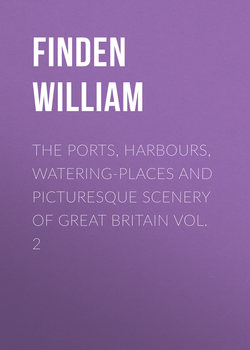Читать книгу The Ports, Harbours, Watering-places and Picturesque Scenery of Great Britain Vol. 2 - Finden William - Страница 15
CAERNARVON CASTLE
Оглавление– "Rifled towers
That, beetling o'er the rock, rear the grey crest
Embattled."
The first royal charter granted in the Principality of Wales was that conferred on the town of Caernarvon by Edward the First. It is a place of great historical interest and importance, and, in connexion with its magnificent castle, presents one of the most imposing features on the British coast. The town is not large; but the recent improvements – public and private – which have been carried into effect have materially contributed to its internal convenience and outward embellishment. Of these the Baths demand especial notice, as one of the principal recommendations to strangers and invalids who resort to this part of the Cambrian shore either for health or relaxation. The building in itself is a good specimen of classical taste – combining elegance of design with excellent workmanship, and presenting, in the distribution of its apartments, every convenience for the reception of visiters and invalids, a choice of hot and cold sea-water baths, with the appendage of comfortable dressing-rooms. For those who have the pleasure in the "cold plunge," as the means of bracing the relaxed system by the exercise of swimming, there is excellent accommodation in a capacious bath, appropriated to that salutary purpose, which is refreshed by a constant supply of water drawn by a steam-engine from the sea through iron pipes, and received into large reservoirs of the same metal. This edifice, which combines in an eminent degree the useful and ornamental, was built at the expense of the Marquess of Anglesey, and is said to have cost upwards of ten thousand pounds.
Within the walls this ancient town is intersected by ten streets, crossing each other at right-angles, which, at various points, fix the stranger's attention by those features and recollections of "other times" with which they are so closely associated. Of these, the main or high street runs from the land to the Water-gate, and is a very fair specimen of that architecture which characterises almost all town buildings of the feudal period. Beyond the walls the town assumes a very different character; elegance, taste, and comfort, and those features which mark the progress of art and refinement, are brought into immediate view; while numerous cottages, and several villas of handsome design and finely situated, throw an air of luxury and domestic comfort over the rural suburbs, the natural character of which is highly favourable to buildings of this description. The town is well paved, lighted with gas, and abundantly supplied with water.
The Port of Caernarvon has accommodation for shipping not exceeding four hundred tons burden, and is frequented by a great number of vessels in the coasting-trade, as well as by others in connexion with London, Liverpool, Glasgow, Dublin, Cork, Bristol, and various port-towns in the United Kingdom. The principal exports consist of slate and copper-ore, the inland transport of which has been greatly facilitated since the construction of the railway. The imports are chiefly colonial produce, Birmingham and Manchester goods, and various articles of home-consumption from the London markets. The quay and harbour of Caernarvon, which formerly presented serious obstacles to the shipping interest on account of the bar at the entrance, have been so improved that the danger, if not entirely removed, is at least so far diminished as to excite little apprehension for the safety of the ordinary craft in connexion with this port. To defray the expense of these public works, Government has levied additional port-dues; and it is much to be wished that, in all other harbours of difficult or dangerous access, the same advantages could be obtained on similar conditions.
